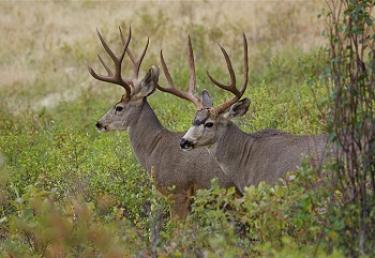How and When to See Deer
Are there deer in your woodland? The following are some telltale signs that deer are present.
- Tracks: Deer hoof prints are unique, looking something like an upside down heart with a hollow middle.
- Scat: Deer scat (or droppings) generally appears as a cluster of 20-30 dark pellets.
- Noticeable browse line: If many deer are present, you may notice a browse line on trees and shrubs that extends just to the height a deer can reach—rarely more than 4 feet above the ground.
- Rubbing sites: Shredded tree bark may indicate a rubbing site, where bucks scrape against trees and shrubs to remove the velvet covering their antlers.
- Bedding areas: Where deer have lain repeatedly to sleep in dense cover, tall grasses, or deep snow, you will find depressions referred to as deer beds.
Find your woodland deer
Once you have observed signs of deer, you can most likely position yourself to see the deer themselves. Deer can be very habitual animals, visiting the same places at the same times of day and taking the same trails that are easily passable to them. So if you find a location that has fresh deer tracks, rubbings, or other signs, the deer or herd that made them is likely to return.
Another way to find deer is to visit a place of good deer forage before dawn or dusk and wait–very quiet and still. Deer are very keen observers with a great sense of smell, hearing and sight, so you’ll need to stay downwind of them and motionless. In areas where deer are hunted, they will likely dart away when they notice you. But if they are on preserve land, they may feel safer and linger as long as you are quiet and don’t get too close.
Deer viewing tip: Fall is a great time to look for deer. Males are preoccupied with doing their breeding show and competing with other males. Females don’t have newborns and are well fed from summer browse. And of course when leaves have fallen visibility is better.
Caution
For your own safety, never get too close to a deer. They can be dangerous at close range, especially a doe who feels her fawn is threatened. And if you find a fawn alone, don’t assume it has been orphaned. Most likely the doe is hidden nearby. Do not handle or move the fawn—if it is moved it will lose the chance to reunite with its mother.
How can I get more tips?
It’s simple! Enter your email below.

